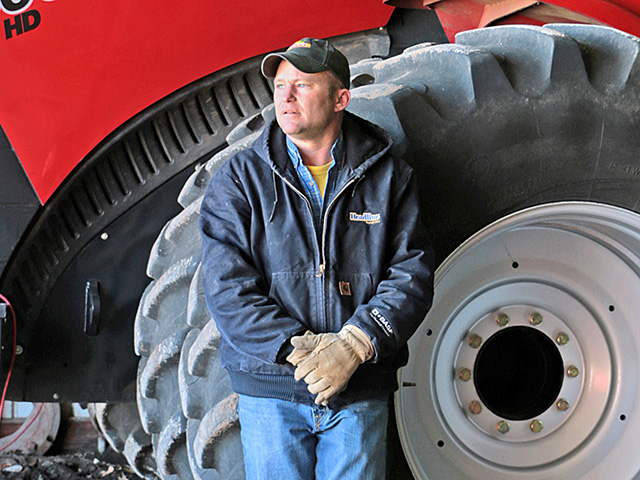Welcome to the 2017 BASF Innovations in the Field. This yearlong program is designed to showcase four progressive farmers and their use of technology and agronomic practices to enhance their return on investment and profit potential. Check back each week for new blogs and videos from the farmers as they share their experiences and crop management decisions throughout the growing season. Here is a brief overview of our four participants.

As JC Henrekin's Deer Grove, Illinois, corn and soybean operation becomes more and more sophisticated, measuring the return of intensified management also grows in complexity.
"Fine-tuning is tough," says Henrekin, who farms 3,800 acres with his semi-retired father, Jim; his brother, Matt; and their partner, Mike Cady. "There are so many year-to-year variables to keep in mind. We use the tools we have to assess changes in management, and we try not to lose focus on the basics. We feel like if we continue to get better at the most basic aspects of raising a crop, yields and profits will follow."
The 2/3 corn, 1/3 soybeans operation in northern Illinois also includes seed corn production for DeKalb and soybean seed production for Asgrow. It's an enterprise where Henrekin and his partners are, "always looking for ways to produce a few more bushels."
"JC is open to trying new things," says BASF Innovation Specialist Chris Norberg, who will help Henrekin investigate new opportunities this season. "He's a smart farmer, and that's the key. They have a great program in place right now, so we're looking at the little things they can do to add bushels economically."
Henrekin has two years under his belt with the 360 Yield Center Y-Drop System. It attaches to a high-clearance sprayer and places liquid fertilizer within a couple of inches of the stalk base rather than halfway between rows like conventional sidedressing. The system's concept is to facilitate late-season, precisely placed nitrogen (N) application for better—and faster—crop access when the nutrient is most needed.
"That's one of the biggest changes [Y-Drop]we've made, and it's proven itself," Henrekin says. "Depending on the field, we are putting on 15 to 20 less total units, and our yields are up. In our sandy soils, we have a low cation exchange, and they can't hold nutrients as well as we'd like. The Y-Drop gives us the opportunity to make sure there's adequate nitrogen available when the plants need it most—going into pollination."
The Y-Drops typically apply 60 to 100 units of nitrogen at V10 to tassel, depending on the field and the amount of rain received. Henrekin has used a soil scan unit to measure nutrient availability and relies on nitrogen prediction models to set the rate.
He puts down dry phosphorus and potassium in the fall on a variable-rate basis established by soil testing every three years. To streamline the workload and hedge his weather bets, he applies anhydrous at 100 pounds per acre to 20% of his corn acres in the fall.
For most corn acres, 100 pounds of anhydrous is applied prior to planting, with an additional 30 units right after planting applied with preemergence chemicals.
This year, Henrekin will take further advantage of the late-season fertilizer application by adding micronutrients to the recipe, particularly sulfur. A recent University of Illinois study indicates steadily dropping atmospheric deposition of sulfate to agricultural fields as a result of Clean Air Act regulations.
"We have used sulfur in previous years but didn't set it up for yield comparisons," Henrekin says. "Now, with it running through the Y-Drop, we will easily be able to do that. We also plan on putting in some check strips of additional micros, as well, in 2017 to evaluate their response."
The big change in soybean production for 2017 will be a total conversion to dicamba-tolerant varieties. Since Henrekin grows soybean seed for Asgrow, he had the opportunity to produce some dicamba-resistant cultivars last year. The new dicamba herbicide products had not been approved, so he couldn't evaluate the chemistry side of the system. However, he gained insight regarding the varieties.
"We did get a look at the yieldability and agronomic characteristics of some of the varieties, and we were pleased," he says. "Glyphosate-resistant waterhemp has become an increasing problem for us, so we'll be using BASF's Engenia along with a residual to address that issue."
Going 100% dicamba-tolerant will be the safest approach, Henrekin believes. He has identified several good-yielding varieties in the Group 2.6 to 3.2 range. With a new protocol, however, he'll be relying on BASF's Norberg for a successful changeover.
"We want to make sure this is a sustainable technology for agriculture," he says. "Engenia is a new, heavier dicamba formulation with dramatically less volatility. Off-target movement is also a function of drift, though, so we have to follow a protocol that keeps the herbicide where we put it."
While dicamba-tolerant soybeans and late-season micronutrient application on corn will be the most dramatic changes on the Henrekin farm this season, there will be plenty of continued "tweaking."
"Over the past several years, we've gotten even more serious about planter performance, achieving better singulation and better uniformity with less delayed seedling development," Henrekin says. "We are also eager to work with a better climate-based predictor of soil nitrogen to make our late-season N application even more effective by variable applying.
"And even though we're convinced about the value of fungicide applications for both corn and beans, we'll continue to run some tests on application timing."
What it all comes down to, Henrekin says, is matching knowledge, experience and technology with the constraints of the marketplace. "The biggest challenge of farming," he concludes, "is making it all work out in the end economically. We're still going for big yields, but those extra bushels have to be profitable."